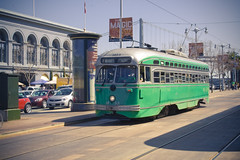 Image by christine.ricks via Flickr
Image by christine.ricks via FlickrSaturday the Transport Politic had an article about New York studying the concept of using historic streetcars in a section of Brooklyn:
New York to Study Red Hook Streetcars, But What Are the City’s Goals?
Also recently the Jacksonville Metro blog talked about San Francisco's historic streetcars and possible uses in Jacksonville:
Streetcars & Waterfronts: The F Market & Wharves Line
I was planning on doing a response to the Jacksonville entry but now the Transport Politic lets me add even more comments to the fire.
First of all, most people know that I believe in streetcars in providing effective Urban Transport. However as I was going to point out and Yonah has done in his blog entry, historic streetcars may not be the best way to go for most cities.
While San Francisco has been extremely successful in not only operating a line of historic streetcars, it is best known for its legendary cable cars that still ply the rails of the city. However, San Francisco is unique in the aspect that its transportation system is also a tourist mecca. While other cities such as Fort Collins, CO and Tucson, AZ among others have historic streetcars running down their streets, San Francisco is the only city I can think of that many people travel to ride historic transit vehicles.
Other cities need to decide what their goals are. Are they trying to provide a modern form of urban transport or are they trying to build a tourist attraction that will not be part of the transit network. Trying to be both is difficult at best.
If the goal is to provide modern urban transport, then you need to design it for those purposes. On the other hand if your goal is to develop a tourist attraction, then it should be totally separate from your transit system so that its success or failure will not affect the important operation of your other transit operations.
Philadelphia has used old PCC cars brought up to modern standards with wheelchair lifts and air conditioning but still have the limits of using rolling stock designed for another generation. Philadelphia did this more to save money over buying new rolling stock but in the long run buying modern equipment may have been the more prudent financial decision.
One thing I will disagree with Yonah about is why streetcars disappeared in the 1930's. He makes the case that buses were more modern than old streetcars and while that may have been true for some, it also fails to point out that streetcar systems were also heavily taxed. In fact many streetcar lines were still making a profit but the taxes they were having to pay not only would not allow them to upgrade their tracks, but it put them badly in the red.
To top it all off, many of their tax dollars were used to fund local roads which was their main competition. Of course is this any different than how many cities used the tax dollars from small businesses to pay for IKEA's, Cabella's, and Wal-Marts who in turn put small companies out of business.

2 comments:
I think with growth in modern urban transport street cars and cable cars should form integral part of San Francisco transportation system that is also known as tourist mecca.
Modern urban ground transportation system need wheelchair lifts and air conditioning features for which very smart and fast move is required. Good Luck!
thank fo posting for any help click here
Designing Buildings
Post a Comment